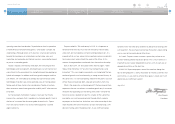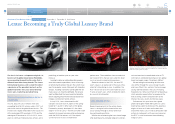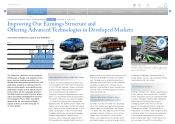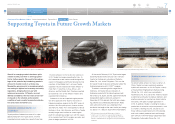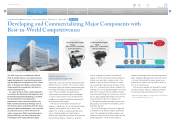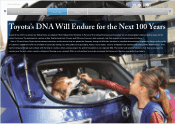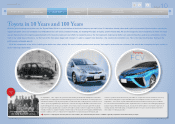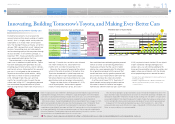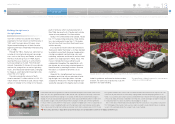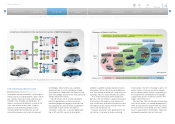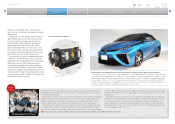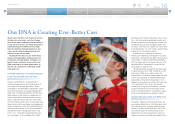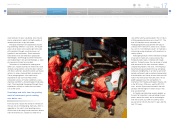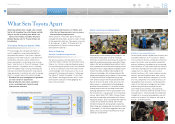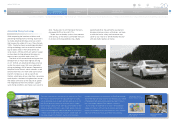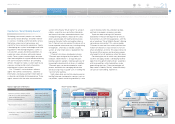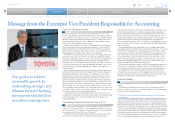Toyota 2014 Annual Report Download - page 14
Download and view the complete annual report
Please find page 14 of the 2014 Toyota annual report below. You can navigate through the pages in the report by either clicking on the pages listed below, or by using the keyword search tool below to find specific information within the annual report.
ANNUAL REPORT 2014
President’s MessagePresident’s Message
Overview of
Four Business Units
Overview of
Four Business Units
Special FeatureSpecial Feature
Review of OperationsReview of Operations
Consolidated Performance
Highlights
Consolidated Performance
Highlights
Management and
Corporate Information
Management and
Corporate Information
Investor InformationInvestor Information
Financial SectionFinancial Section
Page 14
NextPrev
ContentsSearchPrint
Fuel cell vehicles: ideal eco cars
Automobiles can be powered by a wide range of
energy sources, including gasoline, diesel, natural
gas, synthetic liquid fuel, biofuel, electricity, and
hydrogen. Two strategies are being taken to
address environmental problems caused by the
mass consumption of fossil fuels: using less
petroleum and diversifying energy sources.
Combining high thermal efficiency, low fuel
consumption engines and a host of advanced
technologies, hybrid vehicles are a textbook
example of how to use less petroleum. Energy
diversification is a broad field, and Toyota is confi-
dent that hydrogen represents the next promising
energy source of the future.
Fuel cell vehicles run on a motor powered by
electricity generated by a chemical reaction
between hydrogen and oxygen in a fuel cell. The
only byproduct of a fuel cell vehicle in operation is
water vapor. It does not emit any harmful
substances such as CO2, a cause of global warm-
ing, or SO2 and NOx, causes of atmospheric
pollution. In addition to producing zero emissions
when driven, fuel cell vehicles are also highly prac-
tical. Their defining characteristic is their long cruis-
ing range. They can also be refueled very quickly.
As a source of electrical power during emer-
gencies, a fuel cell vehicle is capable of powering
a typical home for roughly a week. Because of
their simultaneous achievement of zero emissions
and high practicality, Toyota positions these vehi-
cles as the ultimate eco-car.
However, one barrier to the proliferation of fuel
cell vehicles is the need to create a refueling
infrastructure in the form of hydrogen stations. To
ensure that our customers are able to operate
fuel cell vehicles reliably, Toyota is cooperating in
the establishment and operation of a hydrogen
supply infrastructure in numerous countries and
regions around the world.
We have more than two decades of experience
with fuel cell vehicles; we started development in
1992 and launched the Toyota FCHV, the world’s
first fuel cell SUV, in December 2002 on a limited
basis in Japan and the United States. Toyota has
developed a proprietary fuel cell stack and
PHV
EV
FCV
HV
Motor
Engine Fuel
tank
Battery
Fuel
tank
Motor
Battery
Motor
Battery
Engine
Motor PCU
Generator Generator
Battery
Engine Fuel
tank
FC
stack
Hydrogen
tank
PCU
PCU
PCU
Breakdown of Mobility in the Future
HV
EV
FCV
FCV (bus)
Vehicle
size
Travel distance
Gasoline, diesel, biofuel, CNG, synthetic fuel, etc.
Passenger
Metropolitan buses
Large trucks
Delivery trucks
Motorcycles
Compact delivery
vehicles
PHV
HydrogenElectricity
Short-distance
applications
Electric vehicles
Hybrid and plug-in hybrid vehicles
Fuel cell vehicles
Energy source
Electric vehicles: short-distance applications Hybrid vehicle and plug-in hybrid vehicles: passenger cars
Fuel cell vehicles: medium and long-distance applications
Comprehensive Development of Next-Generation Eco Cars from a Hybrid Technology Core
Toyotain10Yearsand100Years[5of6] Our DNA is Creating Ever-Better Cars What Sets Toyota Apart Enriching Lives and Building Tomorrow’s Toyota through Innovation New Values for the Next Hundred Years Message from the Executive Vice President Responsible for Accounting
HV: Hybrid vehicle EV: Electric vehicle PHV: Plug-in hybrid vehicle FCV: Fuel cell vehicle


